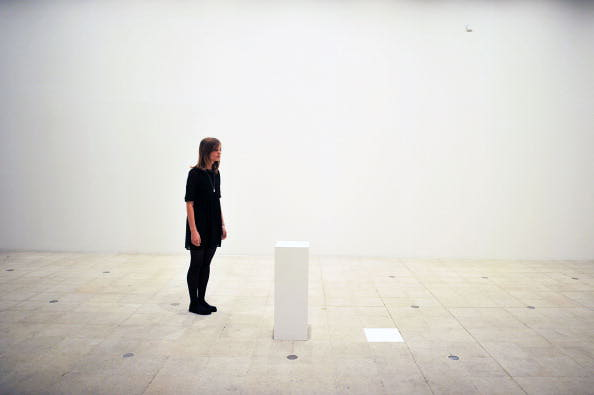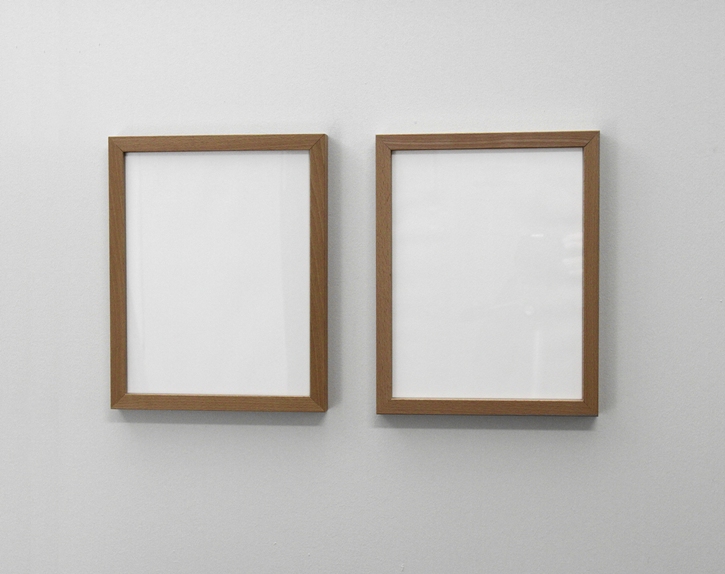In May 1958, Yves Klein invited the Parisian art world to the Galerie Iris Clert for the opening of his latest exhibition, which was entitled The Specialisation of the Sensibility in the Raw Material State of Stabilised Pictorial Sensibility. Driven by ample press coverage, large crowds eagerly awaited the unveiling of the artist’s latest creation, only to be met with nothing. The gallery was empty and the artist best known for his eponymous shade of blue had left colour far behind and painted the entire space white.
While many cried foul, the exhibition was far from a cruel trick. Yet when the Hayward Gallery first announced the premise of their current summer exhibition, numerous were the sceptical murmurs and preemptive criticism. Had the gallery, which in recent years had brought us summer exhibitions that included rowboats on the roof and inflatable environments, turned a corner towards avant-garde ambiguity?
An official police report registers the theft of an invisible artwork from the artist’s car
Invisible is well worth a visit and, fear not, the gallery is not empty. Ironically, the greatest preconceived failing of the Hayward’s show – that there would be nothing to see – is the exhibition’s central point. It directs attention away from the bias that works of art are inherently visual and succeeds in leading the visitor through a theoretically dense terrain of conceptual art with masterful dexterity. The show is, unsurprisingly, heavily text-based and does require a certain amount of patience, but this is really a minor criticism. Here, art often relegated to the confines of avant-garde cliques is demystified without sacrificing its theoretical bite.
Klein’s 1958 exhibition and related late work is the starting point. Next to photographic documents of the notorious exhibition are written correspondence and sketches relating to Klein’s “air architecture”, a project that was utopian in nature: collective dwellings where inhabitants are protected from the elements by walls and ceilings created by jets of air. Klein envisaged that these spaces would not only encourage a more acute awareness of one’s own physical surroundings, but that they would also help dissolve repressive social norms in a realm free from concealment.
 From this historical starting point, the exhibition opens up to reveal a surprising range of work, which is diverse in both method and media in which, with no chronological order, pieces are allowed feed off of each in a dialogue about the “invisible”. Yoko Ono’s Instructions for Painting, for example, are a series of instructions typed on uniformly sized white flash cards which direct the reader through a range of actions, from the simple raising of a hand to looking up at the night sky through the leaves of a tree. Ono’s works evoke the succinct nature of a tightly structured haiku, neatly conceived and evocative. (Pictured above right: Tom Friedman's Untitled (A Curse), 1992)
From this historical starting point, the exhibition opens up to reveal a surprising range of work, which is diverse in both method and media in which, with no chronological order, pieces are allowed feed off of each in a dialogue about the “invisible”. Yoko Ono’s Instructions for Painting, for example, are a series of instructions typed on uniformly sized white flash cards which direct the reader through a range of actions, from the simple raising of a hand to looking up at the night sky through the leaves of a tree. Ono’s works evoke the succinct nature of a tightly structured haiku, neatly conceived and evocative. (Pictured above right: Tom Friedman's Untitled (A Curse), 1992)
A collage of 1965 by Claes Oldenburg poignantly represents his Proposed Underground Memorial and Tomb for President John F. Kennedy: a hollow brass casting of the dead president’s image, equal in size to the Statue of Liberty but to be buried upside down. Meanwhile, satire is nurtured to full humour in Maurizio Cattelan’s Untitled (Denunzia), 1991, an official police report, registering the theft of an invisible artwork from the artist’s car.
 The exhibition also includes several framed pieces of apparently blank paper or canvas. (Pictured above: Gianni Motti's Magic Ink, 1989). For these works, meaning begins with their titles or captions. In Tom Friedman’s 1000 Hours of Staring, 1992–97, we read that the artist stared at the white paper in front of us for over 1,000 hours over the course of five years. Works like this require our trust in the artist, but our gut reaction to disbelieve Friedman’s statement is also part of the artist’s intention. With a short explanation and a simple blank sheet, Friedman manages to ground the importance of process – the actual time and decisions that went into the construction of a piece of art – and makes us question the authority of the artist. Is this piece of white paper really a work of art just because a person who calls himself an artist stared at it? This takes us right back to the Duchamp’s urinal/fountain.
The exhibition also includes several framed pieces of apparently blank paper or canvas. (Pictured above: Gianni Motti's Magic Ink, 1989). For these works, meaning begins with their titles or captions. In Tom Friedman’s 1000 Hours of Staring, 1992–97, we read that the artist stared at the white paper in front of us for over 1,000 hours over the course of five years. Works like this require our trust in the artist, but our gut reaction to disbelieve Friedman’s statement is also part of the artist’s intention. With a short explanation and a simple blank sheet, Friedman manages to ground the importance of process – the actual time and decisions that went into the construction of a piece of art – and makes us question the authority of the artist. Is this piece of white paper really a work of art just because a person who calls himself an artist stared at it? This takes us right back to the Duchamp’s urinal/fountain.
For Glenn Ligon, a blank piece of paper is used as a commentary on race and cultural constructions of the divine. Here again the clue to the work’s meaning is in the title, He Tells me I am His Own. It’s a line from a popular American hymn about a personal encounter with Christ. Ligon uses a white cibachrome print, which resembles a blank photograph, to allude to the fact that the divine presence is usually envisioned as white light, reflecting the bias of “white culture”.
The relationship of text and the invisible finds itself somewhat reversed in a work by Song Dong. In Writing Diary With Water, an on-going work, the artist keeps a diary by writing on stone, a process he has documented through a series of photographs which reveal how the words disappear as the water evaporates. Writing becomes less an act of record but a form of meditation.
The show concludes with Jeppe Hein’s Invisible Labyrinth, 2005 (main picture), an interactive work in which the visitor must navigate with the aid of a head-piece an invisible maze delineated by unseen electrical currents. While this last work may leave you feeling like a poorly guided Pac-Man, its playful nature is more than comic relief. Vision becomes the least important sense, while memory, touch and movement rise to prominence. Like Klein’s gallery, the final room may be empty, but it is the fact of being physically present within the space and interacting in it that is the work of art. Curator Ralph Rugoff leads us through a complex maze of works that are utopian, playful, bitingly political and sometimes hilariously funny.
- Invisible: Art about the Unseen 1957–2012 at the Hayward Gallery until 6 August









![SEX MONEY RACE RELIGION [2016] by Gilbert and George. Installation shot of Gilbert & George 21ST CENTURY PICTURES Hayward Gallery](/sites/default/files/styles/thumbnail_125_x_125_/public/mastimages/Gilbert%20%26%20George_%2021ST%20CENTURY%20PICTURES.%20SEX%20MONEY%20RACE%20RELIGION%20%5B2016%5D.%20Photo_%20Mark%20Blower.%20Courtesy%20of%20the%20Gilbert%20%26%20George%20and%20the%20Hayward%20Gallery._0.jpg?itok=3oW-Y84i)





Add comment